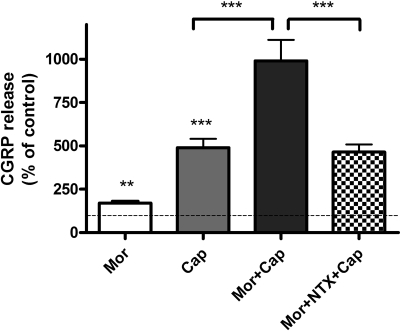Fig. 5.
Sustained morphine-mediated augmentation of capsaicin-evoked CGRP release is opioid receptor-mediated in cultured neonatal rat DRG neurons. Mor, 24-h incubation of cultured DRG neurons with 1 μM morphine augmented CGRP release to 171 ± 11% basal (**, p < 0.01, one-sample t test; n = 5). Cap, treatment of cultured neonatal rat DRG neurons with 1 μM capsaicin for 10 min evoked CGRP release to 489 ± 52% basal (***, p < 0.001, one-sample t test; n = 5). Mor + Cap, 24-h incubation of cultured DRG neurons with 1 μM morphine followed by removal of morphine and stimulation with 1 μM capsaicin for 10 min augmented CGRP release to 991 ± 120% basal, that is, 104% increase relative to capsaicin alone (***, p < 0.001, one-way ANOVA; n = 5). Mor + NTX + Cap, sustained morphine-mediated sensitization of capsaicin-evoked CGRP release was prevented by coincubation with the opioid antagonist naltrexone (464 ± 44% basal; ***, p < 0.001 compared with Mor + Cap group; p > 0.05 compared with Cap group; one-way ANOVA; n = 5). The results (mean ± S.E.M.) are expressed as the percentage of basal CGRP release in unstimulated DRG neurons.

